WouldLatest is another notorious threat for Mac that can cause very significant damage to your system. If your machine is infected by this virus then, you are advised to get rid of this malware immediately. This guide helps you find and remove this virus from your Mac.
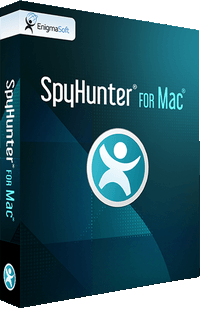
Threats like WouldLatest keep getting back on Mac if all associated files are not removed. So you are advised to use a powerful Malware Removal Tool to run a thorough scan of your mac and delete all threats at once.
WouldLatest virus on Mac
WouldLatest is a malicious adware infection Designed to target Mac computers. This dubious program intrudes on your Mac without permission and silently runs in the background to show unwanted ads and push notifications. This nasty Mac adware infection can force you to visit malicious sites and download dubious programs which can cause further problems. It can contaminate your main web browser to display annoying advertisements.
This nasty malware can change your system and browser settings so that you cannot stop its illegal activities on your machine. It will also suggest you install false updates or useless programs on your system that can bring more threats bundled with them. WouldLatest will keep showing unwanted pop-up ads, banner offers, etc. on your browser that will automatically redirect your browser to a phishing website without your consent.
What is WouldLatest Mac Virus
WouldLatest is an obnoxious malware infection that will destroy your Mac. There is no way you can allow this infection to stay on your machine for a longer time. This dubious threat will keep lurking and tracking your online activities to make an illegal profit. It is a potentially unwanted program (PUP) that also possesses browser-hijacking capabilities. Many users have reported WouldLatest as an unreliable program but they also mentioned that it is not very easy to eliminate. This infection tends to come back after removal.
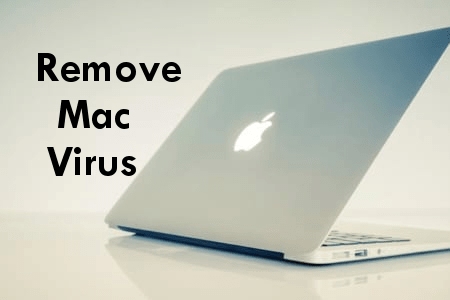
Upon intrusion, it will modify crucial browser settings like the homepage and search engine to allow notifications and pop-ups. It also opens a new tab automatically every time you open your browser. This way, WouldLatest can easily prohibit users from accessing legitimate search providers, like Google, Bing, or Yahoo. All your search queries might get redirected to some shady and unknown search provider that shows lots of sponsored results and advertisements.
As WouldLatest infection is adware, a significant amount of forced ads on your Mac can easily deteriorate your browsing experience through an endless stream of different types of Ads, offers, banners, fake surveys, pop-ups, notifications, etc. Promotion methods used by this threat are highly intrusive and annoying like full-screen ads and fake alerts which may disturb innocent users. The frequency of those ads will keep increasing and very soon lots of unwanted programs will find their way onto your Mac without your knowledge.
How does your Mac get infected?
WouldLatest virus is mostly spread through bundled freeware or shareware program that users download all the time from the Internet. Hackers mostly use cracked software, illegal patches, or fake software updates to spread threats like this on the Internet. They can also deliver viruses to your system directly through spam email attachments that contain malicious codes and execute the malware as soon as your open that email.
Your system can also get infected by the WouldLatest virus when you browse porn or torrent websites, click on misleading ads that redirect your browser to malicious websites, or while sharing files on an unsafe network where hackers put their malicious codes. Sometimes when you search for something online, you might find some ads that will offer free software and when you download, you may end up getting adware on your system that will bombard your computer with various annoying pop-up ads as the WouldLatest virus does.
The Internet is full of information but it also swarming with lots of threats and malware which is looking for a way to compromise your system. So it is very important to stay vigilant and check for any bundled program every time you install software on your Mac and avoid visiting malicious websites.
WouldLatest: Threat Analysis
| Name | WouldLatest |
| Type | Adware |
| Threat Level | High (source to distribute other harmful threats). |
| Symptoms | Users can experience changes in their browsers and an excessive amount of annoying pop-up ads. |
| Distribution | It could be distributed through spam emails, bundled freeware, porn, or torrent sites. |
| Damage | It can modify browsers, show unwanted Ads, steal personal info, and bring other threats. |
| Removal | Download SpyHunter For Mac |
Why it is dangerous
Once this WouldLatest virus manages to enter your computer, it may cause serious damage. It can compromise all famous and mostly used web browsers like Google Chrome, Mozilla Firefox, IE, Opera, Safari, Edge, and others. It can install also install malicious browser extensions or add-ons that will change the homepage or search engine of your browser. This dubious WouldLatest infection can also disable your anti-virus and firewall security to make your system an easy target for other threats and malware. It could spread its malicious copies and associated files at different locations on your system to avoid complete removal.
It can create new files and library entries on your system that will help this malware in getting automatically started every time you boot your Mac. WouldLatest can track your online activities and browsing behavior to show relevant ads on your machine. It can also collect your personal and sensitive information such as your social media login ID, passwords, credit card number, IP address, and many more. It can share those details with hackers to use in illegal online activities for making a profit. So it is very important to remove this virus from your system at the earliest to avoid all these problems.
Harmful Effects of WouldLatest Infection
- Your browser will suddenly start working slowly and crashes very often.
- Various unwanted pop-up ads, banners, offers, etc. will start appearing.
- The browser homepage or search engine might get changed automatically.
- Your browser will start redirecting very often without your consent.
- New toolbars, plugins, or extensions will get installed on your browser.
- New pop-up windows will open every time you click anywhere on the page.
- Your anti-virus or firewall program will stop blocking new threats.
- Your system start-up and shout-down speed will get very slow.
- It may bring more threats and viruses to your computer.
- It can steal your personal information and send it to hackers.
How To Remove WouldLatest
Follow this guide carefully to remove this virus completely from your system. Below you can find step-by-step instructions on how to effectively get rid of this nasty threat easily. Removal of threats like WouldLatest Virus is never easy, so we have simplified the process for you in several small steps.
Quick Summary of Removal Instructions:
- Automatic WouldLatest Removal Guide
- Manual WouldLatest Removal Guide
- Stop Malicious Program From Activity Monitor
- Remove Virus From Application Folder
- Remove Virus Related Files From Mac
- Remove Infection From Your Browser
- Reset Browser Setting to Default
- Prevent WouldLatest Virus in Future
Please Bookmark This Page by pressing the {ctrl+D} button or print it out on paper before you start the removal process because you may need to restart your PC or browser.
Automatic WouldLatest Removal Guide
As you already know, WouldLatest is a notorious and cunning malware that is not hard to remove easily by any user through manual means. This virus can keep coming back on the infected computer through files and shortcuts or settings that it has already created on your machine. Removing all those at once is the only way to get rid of this infection and stop it from getting into your system ever again.
So the best way to remove WouldLatest effectively is to use a powerful Automatic Removal Tool and save your time and efforts. This software is a well-trusted and very powerful anti-malware program that can detect all hidden threats like Trojan, Ransomware, Worms, Spyware, Rootkits, and many others. It is a pretty advanced and effective Mac optimization tool that also provides 24X7 customer support. SpyHunter for Mac is the best app to ensure your Mac’s safety and keep it fast like new always. If you value your Mac then it is the most important application for you. Try this software once and you will never have to worry about any malware attacks.
How SpyHunter for Mac Works
- First, you will have to click on the below download button to get SpyHunter Mac Anti-malware.
Geek’s Recommendation
Threats like WouldLatest keep getting back on the machine if all associated files are not removed. So you are advised to use a powerful Malware Removal Tool to run a thorough scan of your Mac and delete all threats at once.
- After the download, go to the Download Folder from the Docs and Install the SpyHunter For Mac Anti-Malware.
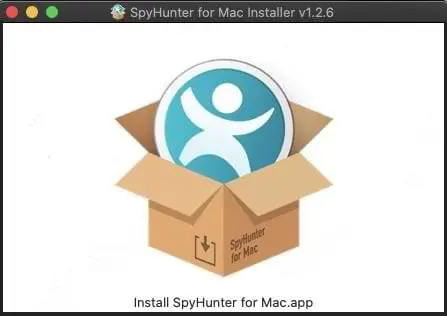
- Once the application is installed launch the Program, and click on Start Scan Now button.
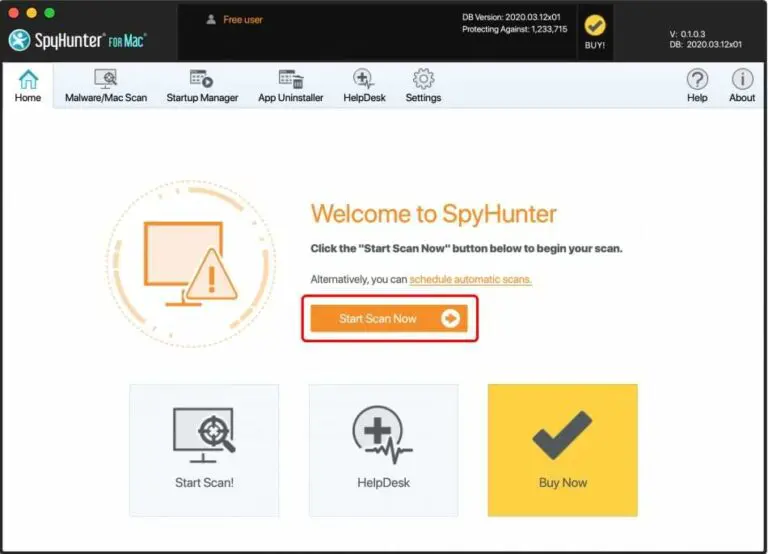
- The software will start running a full scan of your mac instantly to look for any malware, virus, threats, malicious programs or security risks, and so on.
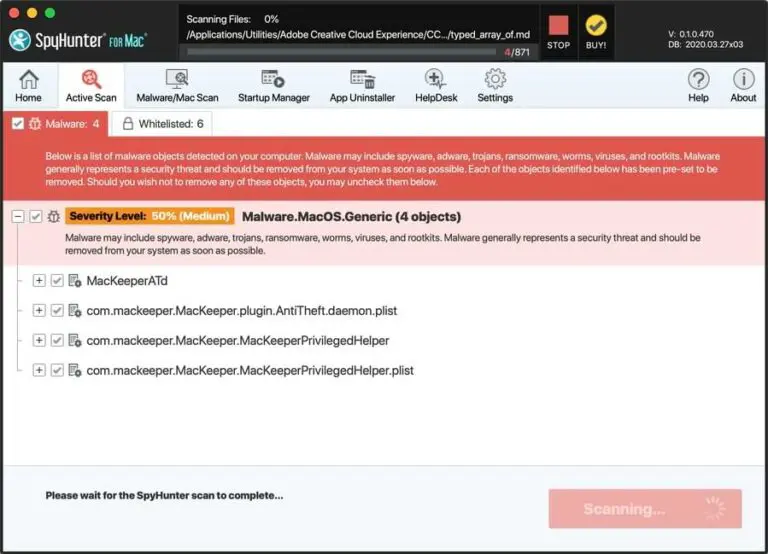
- Finally, you will see a list of malware detected on your mac, now click on the Next button to start the removal process.
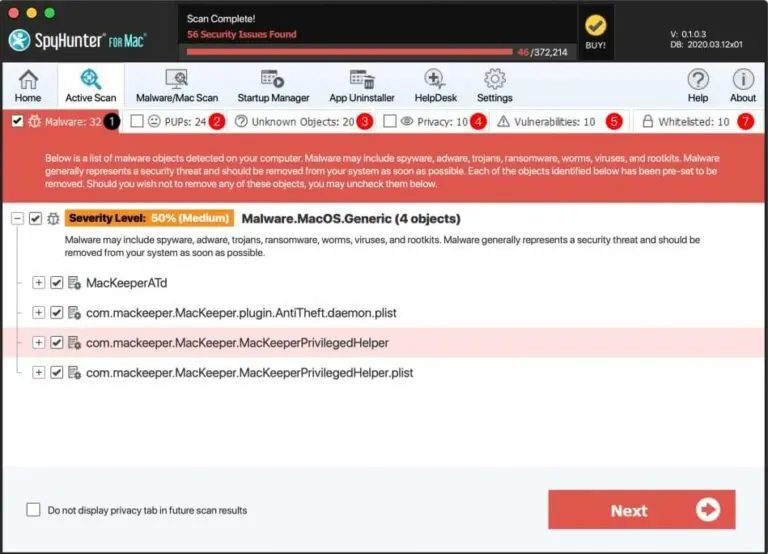
Manual WouldLatest Removal Guide
Attention! For the safety of your system, please confirm a few things before you begin Manual Removal:
- You have done this before, which means you have experience in removing viruses manually;
- That you know your way around Mac and all necessary process and applications;
- You know about LibraryAgents and the serious repercussions of any mistake;
- Make sure you can reverse any mistake made during manual removal.
If you don’t attain any of the above standards, then manual removal could be a very risky idea. It is most likely best for you to use the Automatic Removal Method, which is totally secure and efficient.
Stop Malicious Program From Activity Monitor
- First, you need to open Utilities folder on your Mac system.
- Find the Activity Monitor icon and double-click on it to open.
- Find WouldLatest related process, and click the cross button from the upper left side corner to end the task.
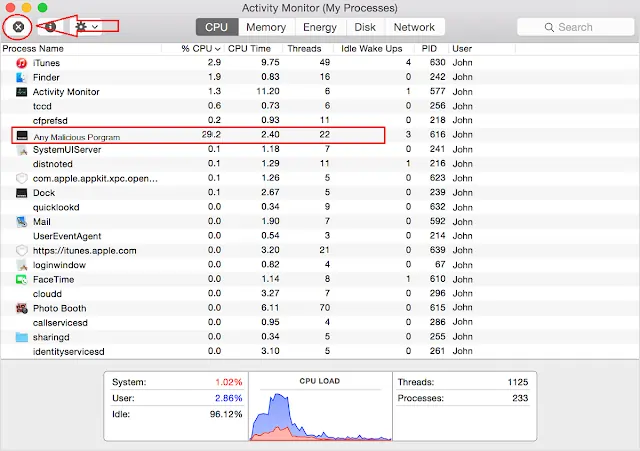
- A pop-up dialogue box will appear on the screen and click on the Force Quit button.

Remove Virus From Application Folder
- First, go to the Dock option (bottom of your screen) then click on Finder App.
- Now you have to open the Applications Folders to see all the programs.
- Find WouldLatest or any other unwanted program then move it to Trash.
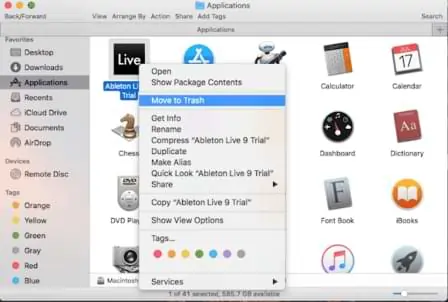
Remove Virus Related Files From Mac
When any program is installed on your Mac, it creates several files on your system that support the functioning of that application. If you need to remove any virus from your Mac, then you need to delete all related files completely. These files could be found at :
- LaunchAgents
- Application Support
- LaunchDaemons
Follow the below steps to remove virus related files from these locations:
- First of all press the Command+Shift+G buttons together on your keyboard.

- Now you can see the Go To Folder option on your Mac screen.
- Type in /Library/LaunchAgents in the text field and click on the Go button.
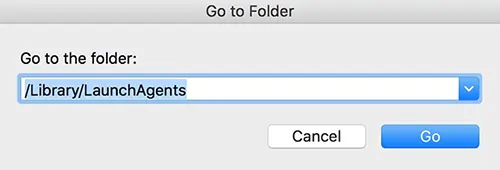
- Find and remove any WouldLatest related or malicious file.
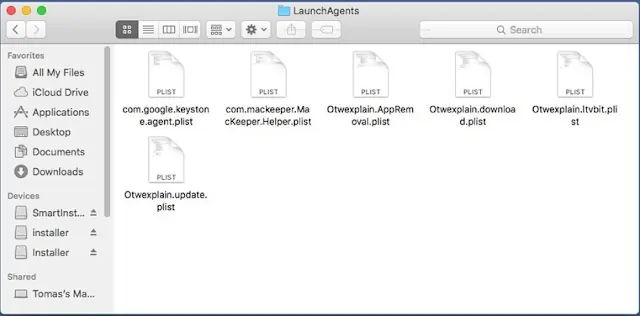
Now follow the same process for Application Support and LaunchDaemons folders. But be careful, don’t delete any important files or you can break down your entire system.
Attention: Don’t go meddling around and deleting files that you don’t know about. Removing any wrong file may damage your Mac. So you are advised to download SpyHunter Mac Anti-Malware and run a thorough scan of your system for threats and viruses.
Remove Infection From Your Browser
Threats like WouldLatest often install malicious extensions to the browser on the infected machine and make several unwanted changes to the browser settings. You might experience forced browser redirection, lots of annoying pop-up ads, and commercials on your browser due to this. You will need to remove the infection from your browser to put an end to such activities and block the regeneration of malware on your system.
Remove WouldLatest From Apple Safari
- Launch the Safari browser on your Mac then click on the Safari menu and select the Preferences option from the drop-down list.
- Now to see the list of all installed extensions on your browser click on the Extensions tab.
- Find the virus related extension and click Uninstall button then again click the Uninstall button to remove the extension completely.
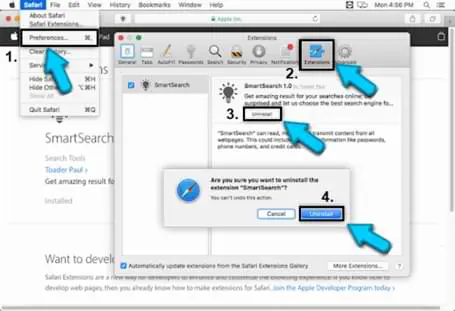
Remove WouldLatest From Google Chrome
Note: Type or copy-paste – chrome://extensions in the URL bar of Google Chrome then press the ENTER button to open the extensions page directly or follow the below steps.
- Launch the Google Chrome browser on your Mac, then click the Menu (⋮) option that you can find in the upper right corner of your browser.
- Chrome drop-down menu will instantly appear, click on More tools then select the Extensions option to see all installed Extensions on your chrome.
- Find any virus related or suspicious extension then click the trash can icon to remove it completely.
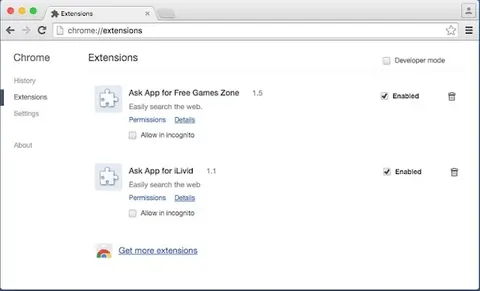
Remove WouldLatest From Mozilla Firefox
Note: Type or copy-paste – about:addons in the URL bar of Firefox then hit ENTER button to open the extensions page directly or follow the below steps.
- Launch the Mozilla Firefox browser on your Mac and then click on the Menu (☰) option which you can find in the upper right corner of the browser.
- You will see a drop-down menu instantly, click on the Add-ons option from that menu.
- On the left sidebar, you will see the Extensions option, click on it to see all installed extensions on your browser.
- Look for any suspicious or potentially unwanted extension then click on the Remove button to get rid of it immediately.
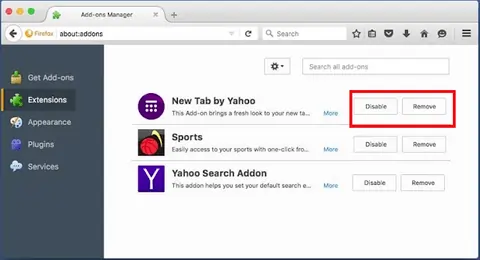
Reset Browser Setting to Default
Once you remove the malicious extensions from your browser, you might want to reset the browser to default settings to reset any changes made by them. Follow the below steps for that :
Reset Safari To Default
- Open your Safari browser, tap on the Safari menu and select the Reset Safari option.
- Now check all the boxes and then finally click on the Reset button.
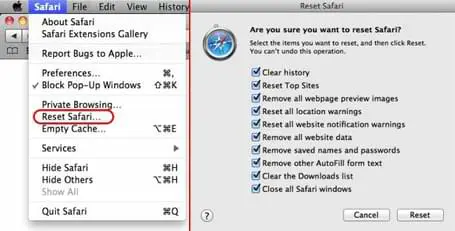
Reset Google Chrome Web Browser
- Open Google Chrome, click on Menu (⋮) then select the settings option.
- On the Settings page, scroll down to the bottom, and click the Show Advanced settings option.
- From Reset and clean up click on Restore settings to their original defaults.
- Finally, click on the Reset Settings button to reset your chrome browser.

Refresh Mozilla Firefox Browser
- Open Mozilla Firefox browser, click on Menu (☰) option, and select the (?) icon.
- Click on the Troubleshooting Information option from the drop-down menu.
- Then press the Refresh Firefox button and give confirmation.
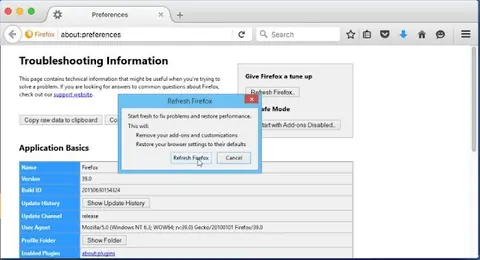
Once you are done with these settings hopefully your problem is solved. If not, then you can also always download the Mac Anti-virus Program mentioned in this article to get rid of all the threats and viruses automatically. You can also take some precautions to avoid similar malware attacks in the future. Follow the below steps to improve the security of your Mac system.
Prevent WouldLatest in Future
- Get a powerful Anti-Malware or Anti-virus to fight cyber threats. Free versions do not offer the best protection and cracked security programs can do more damage than good.
- Always keep your Mac firewall active, and your OS updated along with other important programs. Only download updates from official sites or reliable sources.
- Check HTTPS before entering your email, password, credit card details, etc. to any site. Do not visit sites that do not have SSL security. Also, don’t forget to Enable Phishing and Malware protection in Browser.
- Do not download or install any type of pirated software, games, or illegal patches. Avoid using shady sites to acquire freeware programs because they often use software bundling. Never install a program that asks you to inactivate your anti-virus software.
- Avoid opening spam emails from unknown senders. Always scan all the email attachments before opening them. Never click on any suspicious links with some too good to be true offers.
- Connecting your Mac or iOS devices to unsafe public Wi-Fi is not a good idea. You can also avoid unwanted threats coming from malicious sites by using a VPN to spoof your connection.
- Keep regular backups of all your important data on external hard drives or cloud drives to avoid data loss in case of a ransomware attack. Also, create a Mac Time Machine backup for security purposes.

Leave a Comment